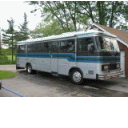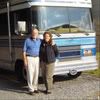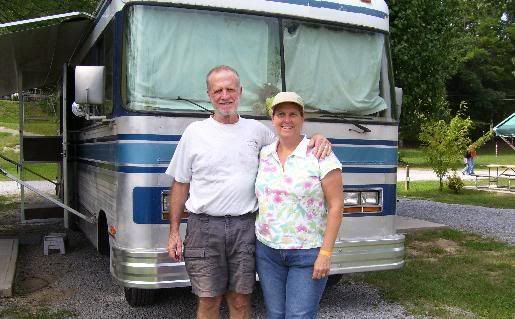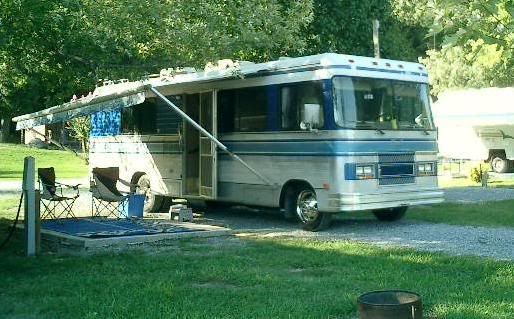Go to...  | Start A New Topic  | Search  | Notify  | Tools  | Reply To This Topic  |  |
Met with Don yesterday and went thru his issues with him. History-The alternator was rebuilt awhile ago and was working before this trip. On the way down to AZ Don noticed that the voltage reading on the dash voltmeter was low and the tach didn't work. Driving maybe 20-30 minutes the tach seemed to come alive and the voltage would be "normal". If the engine would be shut down, once again the tach and voltage readings were not good until some running time later. A mechanic came out an discovered that if the isolator was jumpered, the tach would come alive and the voltage would again be more normal and would stay that way until the engine was shutdown. The mechanic diagnosed the isolator to be bad. All this is great information to start with. When I got there, I did some checking to see if any relay was controlling the "key" input to the alternator. I wasn't getting a good reading of the "key" signal but later found I was not connecting the meter properly. If we jumpered across the isolator yes the alternator would start anx the voltage at the alternator was indeed 13.9 VDC. At both ends of the isolator, the voltage was 13.2-13.3 VDC. That says two things, the alternator when started by flashing the output would run and run normally. The isolator was not bad. After the alternator was rebuilt and until recently, everything worked normally, and because when manually flashed or excited, the alternator would produce normal output, something in the alternator has changed or failed. Isolators specifically are design to "isolate" battery systems and in so doing they also isolate the alternator from the batteries. This is why a single terminal alternator will not work correctly with isolators and is generally known. Alternators with a remote sense and/or "key" enable are the only ones that will work with isolators. I Don's application there is a "key" enable and the proper signal is there. It would be to involved to explain what could be wrong inside the alternator but IMHO it is either the regulator or a bad main diode in the sensing phase of the main output. An alternator bench test should show what is up and should be a relatively inexpensive fix. I don't share the intense dislike for isolators, if properly designed into the charging closed system they work well and do NOT cause a voltage drop. The system I have does not use isolators but a heavy duty solenoid that closes 2-3 minutes after the engine starts. That system also has some rather serious problems. Basically the only system that would insure full battery charging is a three stage regulator controlling the alternator and each battery system has it's own alternator. I will write a detailed explanation to support all this later during my "down" time during travel. Good luck Don, have a safe return and we wil,l get together again! Ed 94 30' Breakaway #3864 30-BS-6B side entry New Cummins 5.9L, 375+ HP Allison 6 speed Spartan chassis K9DVC Tankless water heater | |||
|
 |
Ed I can't thank you enough for stopping by our winter home to diagnose our problem even though you were really headed for Texas. And ... what a treat to finally meet you and your lovely wife. We are going to have to head towards home soon and it is very good to know how to deal with this situation. Heck. thanks to Ed I don't really need to fix it now since he showed me how to "flash" the alternator. I do think it will go into Deer Valley Diesel before we leave for a new or rebuilt alt though. Why not. Do it now is a good idea. Also, Ed showed me how to upgrade my electrical compartment with new relays which will be put off 'til we get home and become a fun project this spring. Thanks again Ed and we will have to meet up again for a visit that doesn't require you to don the coveralls!. Here's a pic of our two coaches at Pioneer RV in far north Phoenix. Don  1990 Regency 34' Cummins 6CTA 8.3 240hp Spartan Chassis, 4 speed Allison MT643 | |||
|
Since it only seemed to work after it had run for a period of time, could it be that there is tarnish on the connections or that they are just a little loose and once everything warms up they either expand to make a tighter connection or are able to get thru the tarnish. It's the old, "check the cables first" thing that i am thinking here. When i first fire up my TR-4 each fall when we get here, a lot of times it will sit there and turn over but not fire off until i rotate one of the glass fuses in place in the fuse holder a few times. No visible corrosion, just a little tarnish that would not appear to have any impact on anything, but it will prevent the engine from starting up. | ||||
|
 |
As a follow up. We went over to Pancho Villa State Park in Columbus, New Mexico on Thursday with no problems . But, when about to leave Saturday found we had no power to the dash guages, directional signals, tail or head lights or the electric radiator fans. Coach started, shifted and ran just fine. I took it for a little spin around town to warm her up, but the cooling fans would not work so back to our site in the park we went! Martin, the park ranger suggested we call Gabriel, the local mechanic, and even though it was Saturday he came over after lunch and dived into the electrical compartment. Very quickly he found that the constant duty solonoid wasn't very constant! He wipped back to the shop and picked one up, installed it and done, everything worked! $80.00 for the house call including the solonoid seemed very reasonable to me! We were outta there heading east on NM 9 towards El Paso by about 2:30 pm. We are now overnighting in a KOA east of Dallas near Greenville and this seems to have cured all our electrical problems. So, Ed you were right! Now we have put the Sunday drive thru the Dallas/Ft. Worth Metroplex behind us there is time to stop and pick up an extra solonoid as a spare for next time. ... BTW, a couple came by just as we arrived at this KOA to say they just recently talked to someone who had come thru in a 77 Barth towing an original VW Beetle! Thanks again. We love our Barth! Don and Patty 1990 Regency 34' Cummins 6CTA 8.3 240hp Spartan Chassis, 4 speed Allison MT643 | |||
|
Just reopened this thread for additional information on Don's charging problems. To prevent confusion, I currently own Don's coach. After the on site 2012 review by Mwrench regarding the alternator charging problems, the exciter lead was moved to another terminal on the battery isolator which corrected most of the issues. There was, however still the intermittent dropping of charge requiring manual flashing across the isolator to get the alternator going. Later in 2012 Don had the alternator redone and upped its capacity to 190 amps. No more problems until November of 2013 when I brought the coach to N.B. For the month of December, I left the start batteries connected. Very cold through the month- extreme ice- no access to compartments. Decided in early January when ice cleared to have a look at the batteries. They were stone dead and frozen- only 9 months old. Warmed them up - slow charge but could not get them past 60% -toasted. Purchased new batteries and placed them today for a test run. Everything ok in normal operation. Now to find the drain which exhausted two fully charged Group 31's in record time. Broke out the Fluke DC clamp on (one of the handiest tools I have ever purchased) and traced the drain to the 16 gauge alternator exciter wire which runs from the alternator to the battery isolator. With everything shut down and ignition off, there is a steady drain of 4.6 amps through to the alternator circuit board. Alternator will have to come off again for a look. Posted this in case anyone else may have a similar issue. Also has anyone else had this problem? Any suggestions as to what's wrong on the board? | ||||
|
Hi Clint, I think that "exciter wire" should come from the key relay, that way when the key is off alternator exciter wire is disconnected and no drain. I don't have the original schematic of your coach so I can't say what was there before or how it was originally connected. On some alternators the "exciter wire" is the source of power to for the "field" and when the alternator is not turning and voltage is low it will draw "field" current as the regulator is trying to maintain charging voltage. Of course it can't because it is not turning. Never the less it still draws current. If you have the alternator part number and something that shows what the various terminals are labeled on the alternator, that might help sove what to do next. AGAIN, isolators work well when they are wired into the system properly and the correct alternator with remote sense is used. Ed 94 30' Breakaway #3864 30-BS-6B side entry New Cummins 5.9L, 375+ HP Allison 6 speed Spartan chassis K9DVC Tankless water heater | ||||
|
Being in the Auto Electric business I can tell you that many alternator repair facilities don't rebuild certain alternators for motorhomes that use isolators properly. Many alternators like Leece Neville and Delco units have to be internally modified to work with an isolator. The proper voltage going into the isolator has to be 15v to allow for the internal voltage drop across the diodes in the isolator in order to get 14.2 volts to the batteries. In our shop we recommend a battery separator Model 1315-200 made by Sure Power Industries. This solves all the concerns with the alternator. After installing over 100 of these units I can say this is the best way to solve your problems once and for all. My professional opinion. | ||||
|
 6/12 6/12Formally known as "Humbojb"  |
And 'Old Blue' has the battery separator Mr. Thomas referred to. One of the nice things is that both the engine and house batteries are charged when running the coach or hooked up to shore power. Tere installed the system last Spring.
| ||||||||||||
|
| First Month Member |
My battery bank is 4 golf cart batteries. They are used for starting and coach power. The advantages are: 1. Very powerful cranking, with less voltage drop, meaning a hotter spark. 2. All four batteries can be used when parked to power the coach. This gives a longer time before recharging is necessary. 3. The engine alternator charges the batteries far better and more quickly than an isolated system. 4. The alternator is charging a battery bank in which all batteries are at the same state of charge. This avoids the problems inherent in charging two parallel banks with different states of charge, such as slow charging of the coach batteries. The one disadvantage is that it is possible to discharge the coach batteries so low that the batteries can be damaged and the genset might not crank. However, if you let this happen, you have not been paying attention. A low battery can be detected by observing light brightness, water pump speed, voltmeter, etc. There are also low battery disconnects or alerts. I have thought of buying or building one, but both Susan and I watch things well enough so that we never discharge too deeply. . 84 30T PeeThirty-Something, 502 powered | |||
|
| First Month Member |
Another simple way to avoid the voltage loss of a silicon diode is to either use a Schottkey diode or a relay. The relay system uses an interesting method of battery isolation and paralleling. The dash switch is an SPDT CO on-off-(on) It has three wires, with the momentary side getting power from the coach battery, the on side getting power from the ignition (or acc terminal of the ignition switch), and the center being the output to the coil of the paralleling relay. So..Start with the switch in off. To charge the coach battery while driving, you have the switch in the on position, which ties the batteries together while the ignition is on and use the momentary position to tie the batteries together when the starting battery is low. The off position is used for normal starting or to charge the chassis battery only. If the switch gets its power from the acc terminal of the ignition switch, then it can be left in on for all normal use, as the acc terminal is usually not energized until the starter is released. This system combines the function of the isolator and the paralleling solenoid without the reduced charging voltage of the isolator. And there are fewer parts and connections than a system with both an isolator and a paralleling relay. However, the rely system, like the isolator, does not address the issue of charging a low and a charged battery in parallel. However, I am not a fan of charging coach batteries in parallel with cranking batteries by the engine alternator, whether through an isolator or a relay. If I wanted to do that, I would have a Perko make-before-break switch in the charging line to allow the alternator to be switched to charge only the coach batteries and respond to their needs only. That switchover would be accomplished a couple minutes after startup, when the start battery was recharged. This is good for daytime driving, but for night driving, the batteries should be paralleled. When the typical motor home with an isolator tries to charge both truck and coach batteries in parallel it responds to the highest battery and the result is a long slow charge for the lower batteries, usually the coach batteries. A heavier alternator never really gets to show its stuff in such a set up. The Winnebago relay solution is elegant in its simplicity, and at least avoids the diode. An isolator drops the charging voltage by around .7 volts, which can result in a sulfated battery with a short service life unless equalized or at least three-staged after the trip. Batteries that are charged by an alternator and are not regularly equalized do not last as long as batteries that are properly fussed over. . 84 30T PeeThirty-Something, 502 powered | |||
|
Official Barth Junkie |
I have a similar relay system now. Because my alternator does not have an external sense wire, when I used a diode splitter the diode drop was an issue... batteries were always .7V lower than I liked. I now use the alternator directly on the starting battery only. I have a heavy relay to parallel the battery sets when needed. Down the road, I use little coach power so I usually don't charge the coach set much, especially if I know I'll be back on the grid that night. On the grid, the Progressive Dynamics charger does very well...batteries are happy and I never have to add water. I have a small digital voltmeter tied to the coach batteries to watch their operation. I got rid of several extra large wires and terminals in the process, less to maintain. 9708-M0037-37MM-01 "98" Monarch 37 Spartan MM, 6 spd Allison Cummins 8.3 325+ hp | |||
|
 3/11 3/11 |
Confused! On my coach the switch by the door has a light that is on when in the "Run" position and off in the "Store" position. It works as described. I replaced the original Barth charger with a Progressive Smart Charger that is connected as the original. It charges and desulfates the coach four golf cart 6 volt batteries fine. MIT does not charge the two 8D chassis batteries and they slowly loos their charge when parked and on shore power because they have a drain for the radio/DVD memory; and other electronics items that have power for remembering date, time and programming. My Leece Neville alternator has the Sense key wire and charges properly while running. I use a portable smart battery charger that I connect to the chassis batteries and they are maintained properly. I believe I have the original isolator that Barth installed. The question is this: "Can/should I consider changing the isolator to the one described above and if so will my system still have the advantage of my Smart Charger that works on my house batteries?" I am thinking that if I can charge both sets with a Smart Charger from shore power I could eliminate the portable one. FYI, my dash mounted paralleling switch works fine when needed. Thanks. P.S. I am asking because I am running out of "updates" for my coach and feel the need to "modernize" where possible. 1993 32' Regency Wide Body, 4 speed Allison Trans, Front Entry door, Diamond Plate aluminum roof & 1981 Euro 22' w Chevy 350 engine and TH 400 tranny | |||
|
A couple of advantages to the 1315-200: 1.) it is bi-directional so if you are plugged in to shore-power or running your generator and any of the batteries need to be charged...including the start batteries the unit will click in and let them take a charge...all automatically. 2.) the 1315-200 also replaces your jump start solenoid and utilizes the same switch on the dash to allow you to have control over the function of combining the battery packs when needed. | ||||
|
I tried a similar relay that would sense charging voltage and then switch on (parallel house and chassis batteries) either to the charger or alternator through a heavy duty relay. Which ever battery was low, it would connect that battery to the charging source if the charging source was above 12.7 VDC. My problem with that is I am a heavy user of the coach (house)batteries and if the charge voltage on the house was increasing because of the charger, the chassis batteries would switch on to get charged also. BTW, I have to add water on the golf cart batteries at least once per trip. During my racing activities, it is not unusual to use 50%-70% of the house battery charge each day! I didn't like this auto connect feature because I needed all the charging current to be available to the house batteries. The solar panels could not charge all the batteries tied together either. I deleted that paralleling function and added a small float charger for the chassis batteries when tied to shore or running off generator power. I don't dry camp long enough for the chassis batteries to run down with out charging. Maintenance is all that is needed for the chassis batteries. The alternator is directly tied to the chassis batteries and after starting, and charge voltage (alternator) getting above 13.3 VDC +/- 3-5 minutes later the paralleling relay will close and all batteries now are getting charged from the main alternator. I have a three stage regulator on the sense line of the alternator so the batteries are charged much the same way as the inverter/charger works while on shore or generator power. When I have time I will add an additional alternator to separate the battery systems completely that way I can insure that house and chassis batteries are maintained properly. I will still be able to use the "AUX" start relay should the chassis batteries ever need a bit of help with starting. Ed 94 30' Breakaway #3864 30-BS-6B side entry New Cummins 5.9L, 375+ HP Allison 6 speed Spartan chassis K9DVC Tankless water heater | ||||
|
| Powered by Social Strata |
| Please Wait. Your request is being processed... |
|
This website is dedicated to the Barth Custom Coach, their owners and those who admire this American made, quality crafted, motor coach.
We are committed to the history, preservation and restoration of the Barth Custom Coach.
We are committed to the history, preservation and restoration of the Barth Custom Coach.



